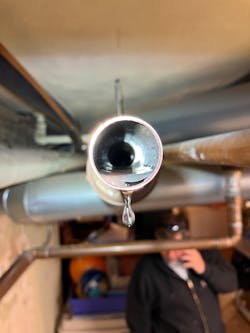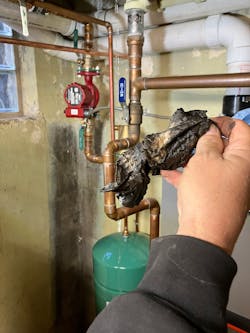It was an unusual problem with old cast iron radiators that were piped for gravity circulation back when the house was built. I had met the contractor before at the house to help him size the replacement high efficiency boiler and decide how to pipe it to the old system. High efficiency hot water boilers work great with cast iron radiators and large pipes.
It’s a perfect mix of the old and new. All that cold water coming back to the boiler creates a lot of condensation—the sign of high efficiency. The more it condenses, the more latent heat is transferred to the water, which results in less heat from the burner escaping up the flue.
It is a single zone system, as most gravity systems are, so the piping would be full flow through the fire tube type heat exchanger. Just one pump to move all that water around. Heck, the water moved around on its own when the house was new, some ninety years ago.
The Problem
The main culprit was in the room they use the most. Go figure. The homeowner also knew the owner of the company, since they were close neighbors for years. So I also got a call from him. (Side note: he was the only person older than me at this year’s local heating association Holiday Dinner.)
Turns out, it wasn’t just one or two radiators. It was every radiator on one side of the house. The piping was originally laid out with two supply/return mains, which is pretty typical of this size house. One main distributes to one side of the house while the other main distributes to the other side. Sometimes it is split front to back.
The new boiler’s supply pipe was toasty warm past the pump, past the branch tee to the problem main, and past the transition from copper to the existing large steel pipe on the working main. The water temperature on the problem main quickly dropped from toasty warm to not warm at all before its connection to the original piping. Radiators weren’t going to heat without circulation.
The Mystery Deepens
This system was converted from gravity to forced circulation some years ago. As I was searching for a reason why the water didn’t want to go where it used to, I found some strange fittings. There were four of them. One each as the pipe changed from 2” to 1”. They had labels that were hard to read, but I could make out “flow-control.” Since I hadn’t seen them before, I suspected that they might be the problem.
As part of the troubleshooting, I slowly closed the valve on the working main to slow flow on that main and hopefully increase flow to the problem main. The more I closed it off, the quicker the boiler cycled off on temperature. It was like the problem main wasn’t getting any flow. It is hard to imagine that the original 2” pipes had a clog or restriction, so I concentrated on the 1” pipe.
On that 1” pipe was that strange fitting, which looked like a reducing coupling. It was 1” on the inlet and 2” on the outlet. The same fitting was on the supply main that was working. I told the installer that we would have to open up the 1” copper pipe on the problem main before the strange fitting to see what it looked like and if through the years some kind of build-up inside was obstructing the flow, my only plausible explanation.
Fortunately, the old ball vales on the existing copper supply lines were leaking at the stem and the homeowner wanted them replaced. That would provide the access I requested, but it was going to be a few days before they could schedule the repair. I told him I wanted to be there. Of course the owner called to check progress. I told him what I suspected, without any confidence that I was right.
Out of Chances
The installer drained the system while my tension grew. The homeowner was right there to watch. The installer then cut the pipe on both sides of the leaky ball valve in the problem main. Water poured out of the side connected to the strange fitting. Immediately, I realized that it must not be clogged if water was pouring out. It soon stopped. If that wasn’t the clog, where was the clog? I’m thinking I’m out of chances.
The other side didn’t have any water coming out, which made some sense since the system was drained. IRight in the branch of the tee to the problem main was the obstruction, a shop towel. It was so close to the pipe cut, the installer was able to reach in and pull it out. Immediately, he declared that it is a blue shop towel and that he uses white shop towels, so it wasn’t left by him. The towel also showed a certain amount of age, and this job was only a week old.
I was relieved that we found the problem, but a question remained. If the towel was there previous to this install, how did the system work fine before? The towel was in the portion of the pipe that was re-used. It could have been loosely lodged in the common 1-1/4” pipe before the branch tee, letting enough flow to each supply main to allow the radiators to heat.
Then, when the new pump turned on and started moving water, the rag moved and got caught in the branch connection, blocking flow to one side. I can’t make this up.
Patrick Linhardt is a thirty-nine-year veteran of the wholesale side of the hydronic industry who has been designing and troubleshooting steam and hot water heating systems, pumps and controls on an almost daily basis. An educator and author, he is currently Hydronic Manager at the Corken Steel Products Co.
About the Author
Patrick Linhardt
Patrick Linhardt is a forty-one-year veteran of the wholesale side of the hydronic industry who has been designing and troubleshooting steam and hot water heating systems, pumps and controls on an almost daily basis. An educator and author, he is currently Hydronic Manager at the Corken Steel Products Co.



